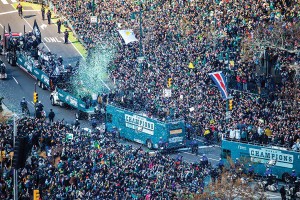How 3,000 Desecrated Black Graves Were Found, and Saved, in South Philly
What if 3,000 Italian or Irish or Jewish or Polish men, women and children from one of the most pivotal periods of American history were buried in a cemetery in Philadelphia? Do you think there would be a city landmark or a state monument or a national treasure to honor it?
Absolutely.
But what if, instead, there were 3,000 African descendants buried in it? There would be no landmark, no monument and no treasure. Quite the contrary, it would be a forgotten trash dump morphed into a city playground. That’s exactly what happened — and is still happening — in South Philly to a former church cemetery.
The Sixth and Lombard site of Mother Bethel A.M.E. Church was bought by Bishop Richard Allen and other trustees in 1791 after which they began services there three years later. In 1810, they purchased the land at what is now Queen and Lawrence streets and used it until 1864 as a private cemetery, known as Bethel Burying Ground.
They were compelled to do so since Philadelphia’s cemeteries would not accept blacks. Things proceeded well until the church began to struggle financially and had to take bold steps in order to avoid allowing the church to be lost to foreclosure. Accordingly, the trustees rented the grounds in 1869 in a 10-year lease for wagon storage to Barnabas Bartol, a white man who operated a sugar refinery. And that contract included the church’s explicit condition that those “who are interred… are to be allowed to remain there undisturbed.”
Despite that, as reported by a local newspaper in 1872, the refinery constantly “dumps rubbish… over the graves.” This caused the cemetery to deteriorate to such an extent that it could no longer function as intended. Therefore, it was sold in 1889 to the white city government that ignored it for a few more years before converting it into a city garden beginning with the planting of saplings in 1901 and attaching a city playground to that garden around 1908. The Department of Recreation took responsibility of the park, known as Weccacoe (a Lenni Lenape word meaning “Pleasant Place”), in 1910.
It is estimated that the remains of as many as 3,000 (if not more) African-American human beings are still beneath that historic Bethel Burying Ground site. They previously included Richard Allen’s wife, abolitionist Sarah Bass Allen, and still include the family of Octavius Catto’s fiancé, civil rights pioneer Caroline LeCount. They were engaged in 1871, but he was murdered later that same year at Ninth and South streets following attacks on blacks by Irish mobs for advocating voting rights.
Those buried also include Ignatius Beck, who helped construct the U.S. Capitol in 1789 and was the first chairman of the Free Produce Society of Philadelphia, which spearheaded boycotts against anything made by slave labor. Black Civil War vets are likely buried there. The names and brief biographies of more than 1,500 black men, women and children are presently known, and information about the other approximately 1,500 is currently being compiled. A few of the ones that are known so far include, alphabetically, Elizabeth Abbot, who died of tuberculosis at age 22 in 1825, and Ann Zittman, who died of lung disease at age 32 in 1848. Chronologically in terms of birth, they include Parker, whose first name and gender were not recorded, who was stillborn 1812, and Phillis Garnet who died at 113 of “old age” in 1823.
How many were enslaved at the time of their death? No one knows for sure, and that’s because not only were most of Mother Bethel’s records “lost” in 1850, but county manumission records were destroyed. However, what we do know is this: The cemetery operated from 1810 through 1864. Slavery in Pennsylvania (specifically, Philadelphia) began in 1684 and ended in 1847 with the last known enslaved person in the state, despite the Commonwealth’s (very) Gradual Abolition Act of 1780. As a result, it is quite probable, if not certain, that the remains of both free and enslaved black folks are beneath those hallowed grounds.
The problem during the past several months seemed to be that no one in the neighborhood associations or in city government gave a damn about those remains. In fact, a project called “Green 2015,” which is a community and municipal plan to turn 500 acres of underused land into green space was ready to go into action, full speed ahead. And Weccacoe was selected as the park to become the plan’s first project, with “green renovation” grants from the local and state governments totaling $535,000. But that project called for playground renovations that required excavations for sewer, water and electrical lines and the planting of trees. So what about the black people buried there? To hell with “Green 2015!” We need “Black 2013!” And we need it in order to finally uncover the literally buried truth about an undeniably historic and absolutely sacred site.
Fortunately, the Philadelphia Historical Commission (PHC) ruled that the site has “yielded and will likely continue to yield information that is important to the City of Philadelphia and its citizens.” Accordingly, the Commission in a unanimous vote just last month placed the land on its Register of Historic Places, which means that it is now legally protected against future disturbance. Also, the Pennsylvania Historical and Museum Commission on Friday concluded an archaeological dig to ascertain the location, depth and width of the actual graves. The conclusions are not expected to be made public for a few months, after which the land will receive protection above and beyond the impressive goals of the PHC.
I must point out that this article could not have been written and the real story about the “Bethel Burying Ground” could not have been told if it had not been for the dogged persistence and meticulous research — and especially the grudging (but relentless) activism — of historian Terry Buckalew who holds a Masters degree in American History with a focus on Ethnic Conflict. He can best be described as a “nice guy who sometimes rubs people the wrong way for the right reasons.”
A totally unassuming gentleman, Mr. Buckalew is not ashamed of pointing out that he stumbled across this historic find while researching the life of Octavius Catto almost seven years ago. He profoundly describes the site as “Philadelphia’s equivalent of Arlington National Cemetery in terms of its historic significance.” Oh, by the way, did I mention that he’s white? Well, he is. So I guess everything I’ve written in this article is a bit more legitimate since it’s not just me, the “Angriest Black Man in America,” saying it. It’s also some regular all-American white guy saying it. And saying it first, I might add.
Mother Bethel’s pastor, Rev. Dr. Mark Tyler, put it well when he said, “The story told by Bethel Burying Ground yesterday is still being told today. The deep-seated racial issues of the past continue to exist in the present. Even in death, we can’t be together. Consider the George Zimmerman verdict in the killing of Trayvon Martin, for example. But we must try to be together in every situation we encounter. In regard to the cemetery, we must protect our history by allowing no further disturbance. We must remember our history by creating a fitting commemoration. And we must interpret our history by culturally enlightening everyone.”
Accordingly, in the interest of this powerful history, let us agitate against further desecration and for renewed consecration. For more info, contact Avenging The Ancestors Coalition at www.avengingtheancestors.com or at 215-552-8751.
This piece was updated to reflect that Caroline LeCount’s family is still buried at Bethel, and that it is likely that Black Civil War vets are buried there.


